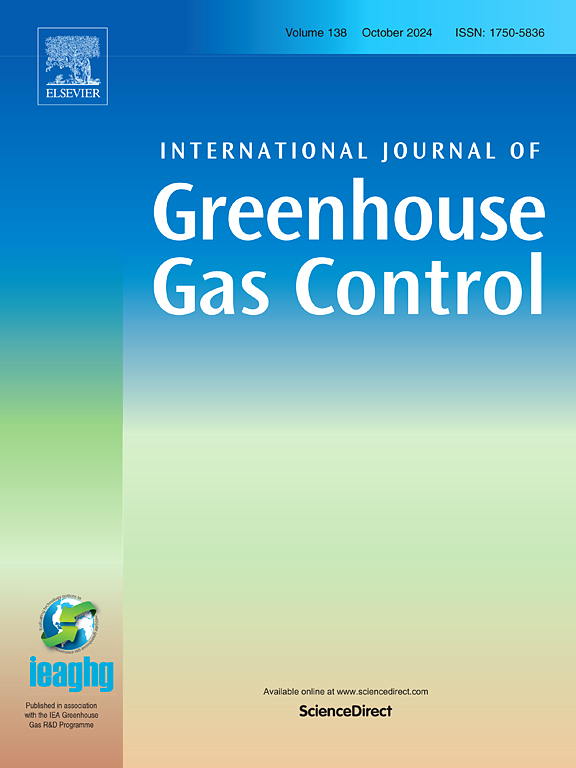An integrated dynamic modeling workflow for acid gas and CO2 geologic storage screening in saline aquifers with faults: A case study in Western Canada
IF 4.6
3区 工程技术
Q2 ENERGY & FUELS
International Journal of Greenhouse Gas Control
Pub Date : 2024-10-01
DOI:10.1016/j.ijggc.2024.104258
引用次数: 0
Abstract
This study investigates the feasibility of storing the acid gas produced from the oil and gas facilities in Southern Saskatchewan into the Basal Sand aquifer using a coupled wellbore-aquifer-compositional reservoir model. The simulations investigate the pressure change around the fault in proximity of the primary storage location incorporating the influence of reservoir permeability, fault transmissibility, and wellbore configuration, on the factors critical to safe and efficient storage, such as plume migration, pressure changes, and CO2 storage capacity. A compositional fluid model created using an equation of state was integrated into the reservoir model. Simultaneous incorporation of fault transmissibility, phase solubility, water salinity, temporal in-situ hysteresis and structural trapping, and in-situ compositional tracking of individual gas components is considered as the main novelty of this work. The main challenge of the study was the lack of available data to characterize the aquifer. To this end, a comprehensive workflow of reservoir studies and modeling was applied to reduce the uncertainties and evaluate the site selection. The Basal sand scoping models reveal that the aquifer is expected to handle the required disposal volume given its extent. The injected acid gas plume migrates laterally and preferentially towards the northwest, away from the fault, owing to the aquifer's geological structure. CO2 remains entirely in the supercritical state, offering storage advantages due to its lower volume. The reservoir permeability significantly impacts the pressure patterns with lower permeability formations triggering higher wellhead injection pressures. Substantial pressure increases around the sealing fault can be observed. Pressure changes of 110 kPa (16 psi) to over 400 kPa (58 psi) were observed at the fault segment after 20 years of continuous gas injection for the expected range of reservoir properties. Mitigation strategies to minimize the increase in fault pressure entail relocating the injection site away from the fault or utilizing a horizontal well trajectory and using an observation well near the fault for monitoring any pressure buildup and slippage.
在有断层的含盐含水层中进行酸性气体和二氧化碳地质封存筛选的综合动态建模工作流程:加拿大西部案例研究
本研究采用井筒-含水层-成分储层耦合模型,对将萨斯喀彻温省南部油气设施产生的酸性气体储存到基底沙含水层的可行性进行了调查。模拟研究了主储存地点附近断层周围的压力变化,包括储层渗透性、断层渗透性和井筒构造对安全高效储存的关键因素(如羽流迁移、压力变化和二氧化碳储存能力)的影响。使用状态方程创建的成分流体模型被集成到储层模型中。同时纳入断层渗透率、相溶解度、水盐度、时间原位滞后和结构捕获以及单个气体组分的原位成分跟踪被认为是这项工作的主要创新之处。这项研究面临的主要挑战是缺乏可用数据来描述含水层的特征。为此,采用了储层研究和建模的综合工作流程,以减少不确定性并评估选址。基底砂范围界定模型显示,考虑到含水层的范围,该含水层有望处理所需的弃置量。由于含水层的地质结构,注入的酸性气体羽流向西北方向横向迁移,远离断层。二氧化碳完全处于超临界状态,由于体积较小,因此具有储存优势。储层渗透率对压力模式有很大影响,渗透率较低的地层会引发较高的井口注入压力。可以观察到密封断层周围的压力大幅上升。在预期的储层属性范围内,连续注气 20 年后,在断层段观察到 110 千帕(16 磅/平方英寸)到超过 400 千帕(58 磅/平方英寸)的压力变化。为尽量减少断层压力的增加,采取的缓解战略包括将注入地点迁离断层,或采用水平井轨迹,并在断层附近打一口观测井,以监测任何压力积累和滑动。
本文章由计算机程序翻译,如有差异,请以英文原文为准。
求助全文
约1分钟内获得全文
求助全文
来源期刊
CiteScore
9.20
自引率
10.30%
发文量
199
审稿时长
4.8 months
期刊介绍:
The International Journal of Greenhouse Gas Control is a peer reviewed journal focusing on scientific and engineering developments in greenhouse gas control through capture and storage at large stationary emitters in the power sector and in other major resource, manufacturing and production industries. The Journal covers all greenhouse gas emissions within the power and industrial sectors, and comprises both technical and non-technical related literature in one volume. Original research, review and comments papers are included.

 求助内容:
求助内容: 应助结果提醒方式:
应助结果提醒方式:


